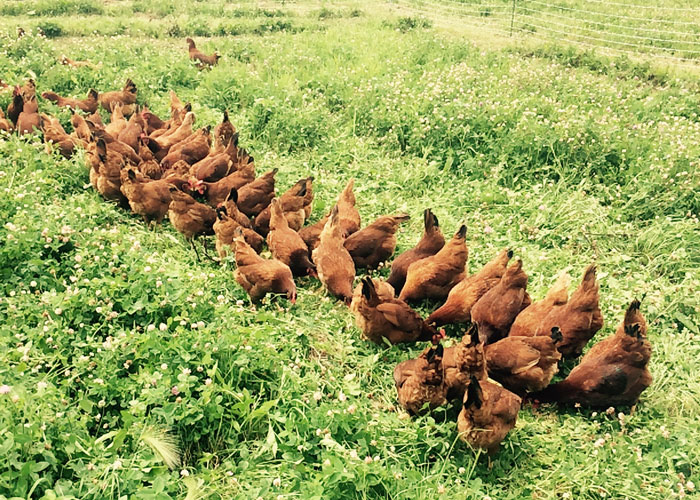
Has anyone ever told you that a farm fresh egg is like the gateway drug to buying local? Okay, maybe that’s just my opinion! But if you’ve never tried an egg from a free range, pastured raised, GMO free organically fed chicken…You haven’t lived!
The old cliche is “c’mon, everyone’s doing it”, and in this situation that’s almost true. There are vast amounts of people making the switch to farm fresh eggs every year! And for good reason; a farm fresh egg is just that, “Fresh”. When you stop at your favorite farm, or visit them at the farmer’s market to pick up your eggs for the week you can bet your bottom dollar they are the freshest eggs you can get! A farm fresh egg is decipherable from its white, confinement house counterpart by many different attributes, and if you ask your grandma how she knew when an egg was good, you would probably get what sounds like some backwoods hillbilly answer. Well I’m here today to put some truth behind that hillbilly notion and show you a few simple ways to pick the best eggs at the market and how to test them when you get home.
What's In a Label?
First things first, not all good eggs are brown, and not all bad eggs are white! What the heck does that mean? Well, large scale egg producers that sell “cage free” eggs have come up with an ingenious way to sell more of their quote unquote high quality eggs; make them all brown. Because people associate a bright white egg with a store bought egg that is cheap and so so quality, so they switched the breed of chicken to lay brown eggs because most people associate a brown egg with phrases like: Cage Free, Vegetarian Fed, Organic and Free Range. Well I’m about to blow the lid of of that fairy tale! The following pictures will display the difference between them all.
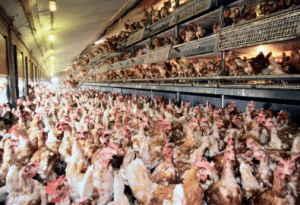
The photo above would constitute a “cage free”, “free range” label on the eggs you buy at the store. That doesn’t look very appealing to me!
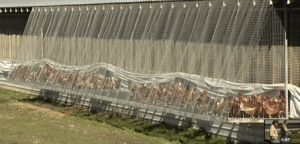
This photo shows the minimum requirement to become certified organic by the USDA. The chickens have to be able to “get outside” if they want. It does not have to be on grass, it doesn’t even have to be on the ground, as long as they can get out of the barn if they desire.
Now I don’t know about you, but I think I would keep looking if these were my grocery store options. A bird that is treated properly and given plenty of time outside to stretch its wings and eat bugs and grass is going to lay a higher quality egg than the ones in the pictures above. The chlorophyll from the green grass and the vitamin D from the sun are what give the pasture-raised egg it’s dark orange yolk. At Ledgeview Gardens we pasture our chickens for 7 months out of the year, on thick stands of prairie grass, clover, buckwheat, peas and other legumes. They are fed a GMO free, certified organic feed and extra calcium to produce strong bones and eggshells. When the weather changes and the grass goes dormant we move them to an insulated shelter and continue to bring them as much greenhouse plant waste as we can. We even go so far as to pick up kitchen scrap from the local school district to supplement their feed with more green material.
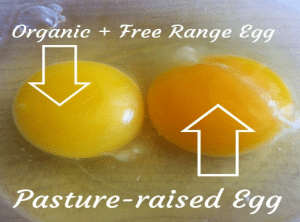
Finding a trustworthy egg supplier isn’t a hard task if you’re shopping at your local farmer’s market. Ask the farmer some questions to ensure he is keeping his birds in a manner that reflects your beliefs.
Testing Your Eggs
Now that you understand the difference in quality of life and eggs between a factory farm chicken and a small farm pasture raised chicken, it’s time to learn how to test the quality and age of your eggs at home.
The first thing you want to do if you are at all concerned about the age of your eggs is to do the float test. This is where I bring a little truth to that hillbilly answer grandma gave you earlier. Fill a tall glass mixing bowl with cool water from your sink; now take your eggs one at a time and place them in the water. If your egg sinks and lays flat to the bottom it is less than one week old; if it sinks but one end raises a little off the bottom it is one week old; if the egg stands on end its narrowest end it is 2-3 weeks old; and if it floats between the middle and top of the water line it is a month or older. The diagram below explains this well.
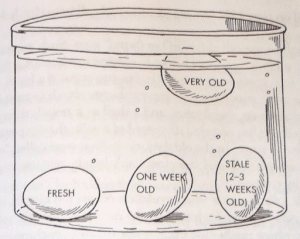
The next way to tell if your egg is fresh or not is to crack one into a pan as if your were going to make a fried egg. If the egg falls into the pan and spreads out over a large area it is getting old. It will probably taste fine, but the quality isn’t there and they should be consumed relatively quickly. If that egg falls into the pan and stays contained and the yolk almost looks as if it is sitting on top of the egg white, you have very fresh eggs and can keep them for up to a month.
After reading this you should have all the necessary information needed to make an informed decision on what to look for and who to buy from at your local market. Congratulations on making the switch and good luck on your search!
Ledgeview Gardens
Buy Local, vote with your wallet